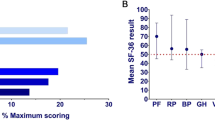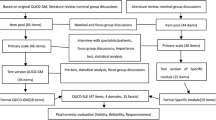Abstract
Objective: To translate into Brazilian–Portuguese, culturally adapt and validate the DLQI. Patients and Methods: The DLQI was translated into Brazilian–Portuguese and cultural adaptation was performed following the methodology proposed by Falcão. Inter-observer reliability and validity were assessed. Seventy-one patients with lupus erythematosus with cutaneous lesions selected from the outpatient dermatology clinic had their quality of life assessed by DLQI and SF-36. The validity of the Brazilian–Portuguese version of the DLQI was evaluated by the correlation of DLQI scores with SF-36 component scores and other outcome measures. Results: In the translation and cultural adaptation process the basic structure of DLQI was kept. Very few questions have very slightly modifications. Of the 71 patients, 83% were women and the median (SD) age was 38 (12) years. The patients had a mean (SD) disease duration of 8(6) years. There were 46 patients with active cutaneous lesions and 37 patients with alopecia. The DLQI inter-observer reliability coefficient was 0.96 (p<0.001). The DLQI mean (SD) score was 6.5 (5.6) and most of the SF-36 domains were between 60 and 70. The domains that had the lowest scores were ‘general health’ (62) and ‘mental health’ (62). The Pearson correlation coefficient between DLQI and each SF-36 component score were highly statistically significant (p<0.001), despite of being only moderate. As expected there was no correlation between DLQI or each one of the SF-36 components and age, disease duration or number of ACR criteria. Patients with active cutaneous lesions presented statistically significant lower scores of DLQI and SF-36 when compared to patients without active cutaneous lesions. Patients with alopecia presented a statistically significant lower score in DLQI when compared to patients without alopecia. Conclusions: The results suggest that the Brazilian–Portuguese version of the DLQI is a reliable and valid outcome measure to be used in LE clinical studies.
Similar content being viewed by others
References
AY Finlay GK Khan (1994) ArticleTitleDermatology Life Quality Index (DLQI) – a simple practical measure for routine clinical use Clin Exp Dermatol 19 210–216 Occurrence Handle1:STN:280:ByuA3cnntVI%3D Occurrence Handle8033378
D Mota Falcão Particleda (1999) Processo de tradução e adaptação de questionários de qualidade de vida: avaliação de sua metodologia [tese] Escola Paulista de Medicina-UNIFESP São Paulo
D Mota Falcão Particleda RM Ciconelli MB Ferraz (2003) ArticleTitleTranslation and cultural adaptation of quality of life questionnaires, an evaluation of methodology J Rheumatol 30 IssueID2 379–385 Occurrence Handle12563699
C Bombardier DD Gladman MB Urowitz D Caron CH Chang (1992) ArticleTitleand The Committee on Prognosis Studies In SLE. Derivation of the SLEDAI-A disease activity index for lupus patients Arthritis Rheum 35 IssueID6 630–640 Occurrence Handle1:STN:280:By2B1cjhvVA%3D Occurrence Handle1599520
EM Tan AS Cohen JF Fries (1982) ArticleTitleThe 1982 revised criteria for the classification of SLE Arthritis Rheum 25 1271–1277 Occurrence Handle1:STN:280:BiyD2cfksFI%3D Occurrence Handle7138600
RM Ciconelli (1997) Tradução para o português e validação do questionário genérico de avaliação de qualidade de vida “Medical Outcomes Study 36-item Short-Form Health Survey (SF-36) [tese] Escola Paulista de Medicina-UNIFESP São Paulo
RM Ciconelli MB Ferraz W Santos I Meinão MR Quaresma (1999) ArticleTitleBrazilian–Portuguese version of the SF-36. A reliable and valid quality of life outcome measure Revista Brasileira de Reumatologia 39 143–150
MB Ferraz LM Oliveira PM Araujo E Atra P Tugwell (1990) ArticleTitleCrosscultural reability of the physical ability dimension of the Health Assessment Questionnaire J Rheum 17 813–817 Occurrence Handle1:STN:280:By%2BA2MrgvFc%3D Occurrence Handle2388204
G Guyatt DH Feeny DL Patrick (1993) ArticleTitleMeasuring health-related quality of life Ann Intern Med 8 622–629
V Lewis AY Finlay (2004) ArticleTitle10 years experience of the Dermatology Life Quality Index (DLQI) J Investig Dermatol Symp Proc 9 IssueID2 169–180 Occurrence Handle10.1111/j.1087-0024.2004.09113.x Occurrence Handle15083785
AY Finlay (1997) ArticleTitleQuality of life measurement in dermatology: A practical guide Br J Dermatol 136 305–314 Occurrence Handle10.1046/j.1365-2133.1997.5541510.x Occurrence Handle1:STN:280:ByiB2cjjtFw%3D Occurrence Handle9115906
S Aghaei M Sodaifi P Jafari N Mazharinia AY Finlay (2004) ArticleTitleDLQI scores in vitiligo: Reliability and validity of the Persion version BMC Dermatol 4 IssueID1 8 Occurrence Handle15294022
E Mazzotti A Picardi F Sampogna F Sera P Pasquini D Abeni (2003) ArticleTitleIDI Multipurpose psoriasis research on vital experiences study group. Sensitivity of the Dermatology Life Quality Index to clinical change in patients with psoriasis Br J Dermatol 149 IssueID2 318–322 Occurrence Handle10.1046/j.1365-2133.2003.05378.x Occurrence Handle1:STN:280:DC%2BD3szpsFCkuw%3D%3D Occurrence Handle12932238
K Yaziei K Baz AE Yaziei et al. (2004) ArticleTitleDisease specific quality of life is associated with anxiety and depression in patients with acne J Eur Acad dermatol Venearol 18 IssueID4 435–439
HA Kurwa AY Finlay (1995) ArticleTitleDermatology in patient management greatly improves life quality Br J Dermatol 133 575–578 Occurrence Handle1:STN:280:BymD1MnosF0%3D Occurrence Handle7577587
E Poon PT Seed MW Greaves KA Black (1999) ArticleTitleThe extend and nature of disability in different urticarial conditions Br J Dermatol 140 667–671 Occurrence Handle10.1046/j.1365-2133.1999.02767.x Occurrence Handle1:STN:280:DyaK1M3ltVSmsw%3D%3D Occurrence Handle10233318
X Badia JM Mascaro R Lozano (1999) ArticleTitleMeasuring health-related quality of life in patients with mild to moderate eczema and psoriasis: Clinical validity, reliability and sensitivity to change of the DLQI Br J Dermatol 141 698–702 Occurrence Handle10.1046/j.1365-2133.1999.03112.x Occurrence Handle1:STN:280:DC%2BD3c%2FltVajsA%3D%3D Occurrence Handle10583119
Author information
Authors and Affiliations
Corresponding author
Rights and permissions
About this article
Cite this article
Ferraz, L.B., Almeida, F.A., Vasconcellos, M.R. et al. The Impact of Lupus Erythematosus Cutaneous on the Quality of life: The Brazilian–Portuguese Version of DLQI. Qual Life Res 15, 565–570 (2006). https://doi.org/10.1007/s11136-005-2638-9
Accepted:
Issue Date:
DOI: https://doi.org/10.1007/s11136-005-2638-9




